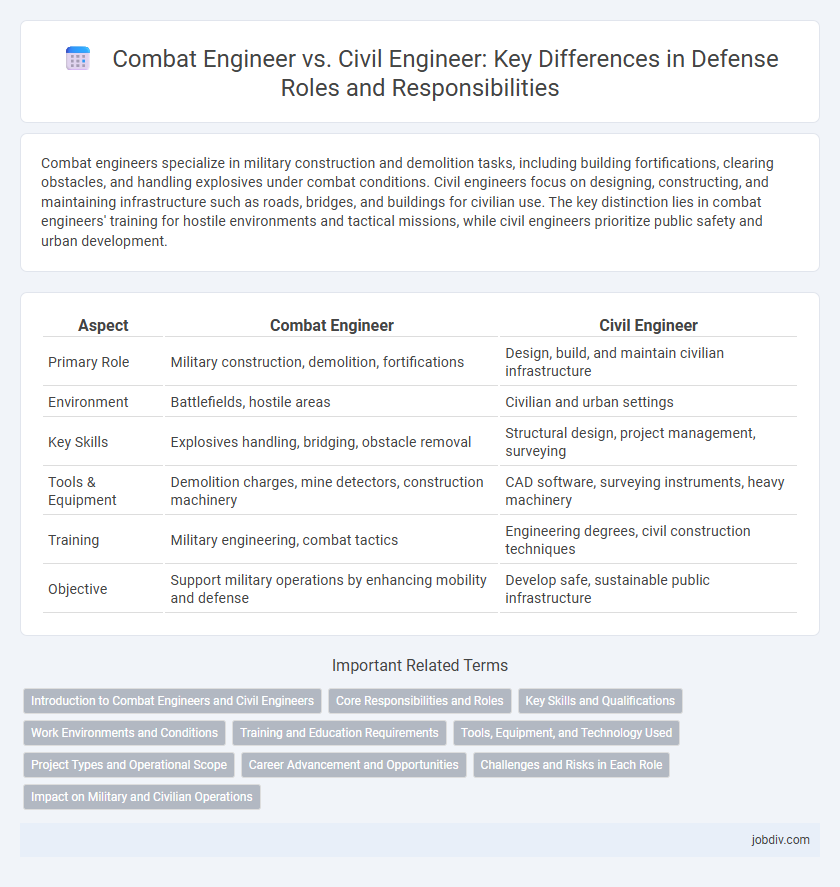Combat engineers specialize in military construction and demolition tasks, including building fortifications, clearing obstacles, and handling explosives under combat conditions. Civil engineers focus on designing, constructing, and maintaining infrastructure such as roads, bridges, and buildings for civilian use. The key distinction lies in combat engineers' training for hostile environments and tactical missions, while civil engineers prioritize public safety and urban development.
Table of Comparison
| Aspect | Combat Engineer | Civil Engineer |
|---|---|---|
| Primary Role | Military construction, demolition, fortifications | Design, build, and maintain civilian infrastructure |
| Environment | Battlefields, hostile areas | Civilian and urban settings |
| Key Skills | Explosives handling, bridging, obstacle removal | Structural design, project management, surveying |
| Tools & Equipment | Demolition charges, mine detectors, construction machinery | CAD software, surveying instruments, heavy machinery |
| Training | Military engineering, combat tactics | Engineering degrees, civil construction techniques |
| Objective | Support military operations by enhancing mobility and defense | Develop safe, sustainable public infrastructure |
Introduction to Combat Engineers and Civil Engineers
Combat engineers specialize in military construction, demolition, and fortification to support battlefield operations, including building bridges, clearing obstacles, and handling explosives. Civil engineers focus on designing and constructing public infrastructure such as roads, buildings, and water systems to improve civilian life and urban development. Both professions require technical expertise but serve distinct purposes--combat engineers operate in tactical environments, while civil engineers contribute to peaceful infrastructure planning and development.
Core Responsibilities and Roles
Combat engineers specialize in military construction, demolition, and battlefield obstacle clearance to support tactical operations and enhance troop mobility. Civil engineers design, plan, and oversee infrastructure projects such as roads, bridges, and buildings, ensuring safety, functionality, and compliance with regulations. Both roles require technical expertise, but combat engineers operate under combat conditions with a focus on mission-critical engineering tasks.
Key Skills and Qualifications
Combat engineers possess specialized skills in explosives handling, fortification construction, and battlefield mobility support, requiring rigorous physical fitness and military training. Civil engineers focus on designing, planning, and overseeing infrastructure projects, emphasizing expertise in structural analysis, materials science, and project management. Both fields demand strong problem-solving abilities and technical knowledge, but combat engineers operate in high-risk, tactical environments, while civil engineers work primarily in civilian construction and development sectors.
Work Environments and Conditions
Combat engineers operate in high-risk, often hostile environments such as battlefields, where they construct fortifications, clear obstacles, and handle explosives under combat conditions. Civil engineers work primarily in controlled, non-combat settings such as urban infrastructure projects, construction sites, and office environments focused on designing and maintaining public works. The physical demands and safety risks for combat engineers are significantly greater due to exposure to enemy fire, explosives, and unpredictable terrain compared to the more regulated and predictable conditions faced by civil engineers.
Training and Education Requirements
Combat engineers undergo rigorous military training focused on combat tactics, demolition, minefield breaching, and fortification construction, often starting with basic combat training followed by specialized engineer courses. Civil engineers require a formal education including a bachelor's degree in civil engineering, with courses in mathematics, physics, and materials science, and they must often obtain professional licensure such as the PE (Professional Engineer) certification. While combat engineers emphasize practical, tactical skills for battlefield support, civil engineers focus on design, analysis, and project management for infrastructure development.
Tools, Equipment, and Technology Used
Combat engineers utilize specialized tools such as explosives, breaching equipment, and armored vehicles designed for rapid construction and demolition in hostile environments. Civil engineers rely on precision instruments like surveying equipment, CAD software, and heavy machinery to design and construct infrastructure with long-term durability. Advanced technologies including GPS, drones, and remote sensing enhance efficiency in both fields, but combat engineers prioritize mobility and tactical advantage while civil engineers focus on structural integrity and urban planning.
Project Types and Operational Scope
Combat Engineers primarily engage in military construction, fortification building, obstacle clearing, and demolition tasks that support infantry and armored units in the battlefield. Civil Engineers focus on designing and constructing public infrastructure projects such as roads, bridges, dams, and urban development to enhance civilian life and economic growth. The operational scope of Combat Engineers is tactical and mission-driven within conflict zones, while Civil Engineers operate in peacetime environments with long-term infrastructure planning and maintenance.
Career Advancement and Opportunities
Combat Engineers gain rapid career advancement through specialized military training, leadership roles in field operations, and combat-related skills, positioning them for roles in defense project management and strategic planning. Civil Engineers benefit from diverse opportunities in infrastructure development, with career growth linked to certifications, advanced degrees, and experience in public or private sector projects. Both professions offer pathways to senior leadership, but Combat Engineers leverage operational experience while Civil Engineers capitalize on technical expertise in civilian and defense infrastructure.
Challenges and Risks in Each Role
Combat engineers face high-risk environments involving explosive ordnance disposal, battlefield fortifications, and rapid infrastructure repair under enemy fire, requiring specialized training in hazardous conditions and immediate threat mitigation. Civil engineers encounter challenges related to large-scale infrastructure projects such as bridges, roads, and public utilities, managing environmental impact, regulatory compliance, and long-term safety standards in urban or rural settings. Both roles demand precision and problem-solving skills, but combat engineers operate under acute physical danger, while civil engineers address complex logistical and structural risks.
Impact on Military and Civilian Operations
Combat engineers enhance military operations by constructing fortifications, clearing obstacles, and enabling mobility under hostile conditions, directly impacting mission success and troop safety. Civil engineers play a vital role in civilian infrastructure, designing and maintaining roads, bridges, and public utilities essential for societal functioning and emergency response. The distinct expertise of combat engineers and civil engineers ensures both effective defense strategies and resilient civilian infrastructure.
Combat Engineer vs Civil Engineer Infographic

 jobdiv.com
jobdiv.com